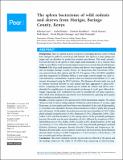| dc.contributor.author | Rehema Liyai, Gathii Kimita, Clement Masakhwe, David Abuom, Beth Mutai, David Miruka Onyango, John Waitumbi | |
| dc.date.accessioned | 2022-01-22T08:51:10Z | |
| dc.date.available | 2022-01-22T08:51:10Z | |
| dc.date.issued | 2021 | |
| dc.identifier.uri | https://repository.maseno.ac.ke/handle/123456789/4505 | |
| dc.description.abstract | There is a global increase in reports of emerging diseases, some of which have emerged as spillover events from wild animals. The spleen is a major phagocytic organ and can therefore be probed for systemic microbiome. This study assessed bacterial diversity in the spleen of wild caught small mammals so as to evaluate their utility as surveillance tools for monitoring bacteria in an ecosystem shared with humans.
Methods
Fifty-four small mammals (rodents and shrews) were trapped from different sites in Marigat, Baringo County, Kenya. To characterize their bacteriome, DNA was extracted from their spleens and the V3–V4 regions of the 16S rRNA amplified and then sequenced on Illumina MiSeq. A non-target control sample was used to track laboratory contaminants. Sequence data was analyzed with Mothur v1. 35, and taxomy determined using the SILVA database. The Shannon diversity index was used to estimate bacterial diversity in each animal and then aggregated to genus level before computing the means. Animal species within the rodents and shrews were identified by amplification of mitochondrial cytochrome b (cytb) gene followed by Sanger sequencing. CLC workbench was used to assemble the cytb gene sequences, after which their phylogenetic placements were determined by querying them against the GenBank nucleotide database.
Results
cytb gene sequences were generated for 49/54 mammalian samples: 38 rodents (Rodentia) and 11 shrews (Eulipotyphyla). Within the order Rodentia, 21 Acomys, eight Mastomys, six Arvicanthis and three Rattus were identified. In the order Eulipotyphyla, 11 Crucidura were | en_US |
| dc.publisher | PeerJ Inc. | en_US |
| dc.subject | Wild mammals, Rodents, Shrews, Zoonosis, Spleen microbiome, 16S rRNA, Bacteria diversity, Next Generation Sequencin | en_US |
| dc.title | The spleen bacteriome of wild rodents and shrews from Marigat, Baringo County, Kenya | en_US |
| dc.type | Article | en_US |

